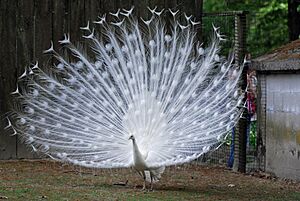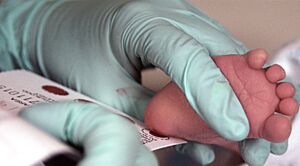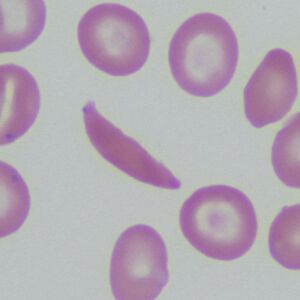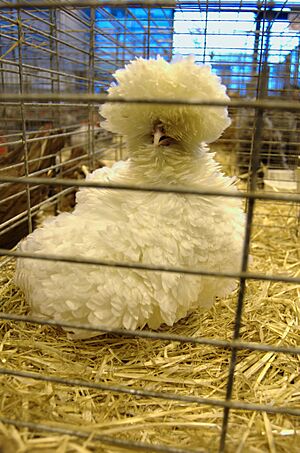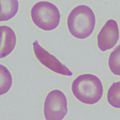Pleiotropism facts for kids
Pleiotropy is a cool idea in genetics. It means that a single gene can affect many different traits or features in an organism. Imagine one gene being like a master switch that turns on several different lights!
Often, these effects might seem totally unrelated. This happens because the same gene can be active in different parts of the body, like different tissues or organs. Since most genes work in more than one place, pleiotropy is actually very common.
Contents
How Pleiotropy Affects Evolution
Pleiotropy is important for understanding evolution. Sometimes, certain features in animals are not just there because they help the animal survive directly. Instead, they might be side effects of a gene that was strongly chosen for another, more important trait.
For example, if a gene helps an animal survive really well in one way, it might also cause another trait that isn't as helpful, or is even a little bit bad. But because the main effect is so good, the gene (and its side effects) still get passed on.
When Genes Have Mixed Effects
Sometimes, a gene can have effects that are both good and bad for an organism. This is called antagonistic pleiotropy. Here are a few ways this can happen:
- A gene might cause some traits that are harmful, but these bad effects are outweighed by other very helpful traits from the same gene. The good effects help the organism survive more, so the gene sticks around.
- A gene might help an organism a lot when it's young and able to have babies. But later in life, the same gene might cause problems. Since the gene helps with reproduction when young, it gets passed on, even if it causes issues later.
- A gene might be helpful in one habitat or environment, but not in another. For example, some bacteria have a gene that helps them use glucose (a type of sugar) really well. This is great if there's lots of glucose around. But if the only food source is something else, like lactose, that same gene might make it harder for them to use it, which could be bad.
Examples of Pleiotropy
Many traits and even some diseases are examples of pleiotropy.
Albinism
Albinism is a condition where an organism cannot produce enough melanin, which is the pigment that gives color to skin, hair, and eyes. A single gene mutation can cause albinism. This one gene affects:
- Skin color: It becomes very pale.
- Hair color: It becomes white or very light.
- Eye color: Eyes can be light blue, gray, or even pinkish-red because the blood vessels show through.
- Vision problems: People with albinism often have issues with their eyesight, like being very sensitive to light or having trouble focusing.
All these different effects come from just one gene not working correctly.
Phenylketonuria (PKU)
Phenylketonuria (PKU) is a genetic disorder that affects how the body breaks down a substance called phenylalanine, which is found in many foods. A single gene mutation causes PKU. If not treated, it can lead to several problems:
- Brain damage: High levels of phenylalanine can harm the brain, leading to learning difficulties.
- Skin problems: People with PKU might have lighter skin, hair, and eyes than their family members.
- Odor: They might also have a musty smell in their breath, skin, or urine.
Doctors usually test babies for PKU soon after they are born, so treatment can start early to prevent serious problems.
Sickle Cell Disease
Sickle cell disease is a blood disorder caused by a change in just one gene. This gene affects hemoglobin, a protein in red blood cells that carries oxygen. The change makes red blood cells become stiff and shaped like a crescent moon (a sickle). This one gene change leads to many different symptoms:
- Anemia: The sickle cells don't live as long as normal red blood cells, causing a shortage of healthy cells.
- Pain crises: The sickle cells can block blood flow in small blood vessels, causing severe pain.
- Organ damage: Over time, blocked blood flow can damage organs like the spleen, kidneys, and lungs.
- Increased infections: People with sickle cell disease are more likely to get infections.
Frizzle Fowl Trait
Chickens with the frizzle feather trait have feathers that curl outwards instead of lying flat. This unique look is caused by a single gene. But this gene doesn't just affect feathers; it also causes other traits:
- Feather structure: The main effect is the curled feathers.
- Body temperature: Frizzle chickens have trouble keeping warm because their feathers don't insulate them well.
- Metabolism: They often have a higher metabolism, meaning their bodies burn energy faster to try and stay warm.
- Egg laying: They might lay fewer eggs than other chickens.
So, one gene affects their feathers, body temperature, and even how many eggs they lay!
Images for kids
-
Photomicrograph of normal-shaped and sickle-shape red blood cells from a patient with sickle cell disease
See also
 In Spanish: Pleiotropía para niños
In Spanish: Pleiotropía para niños



